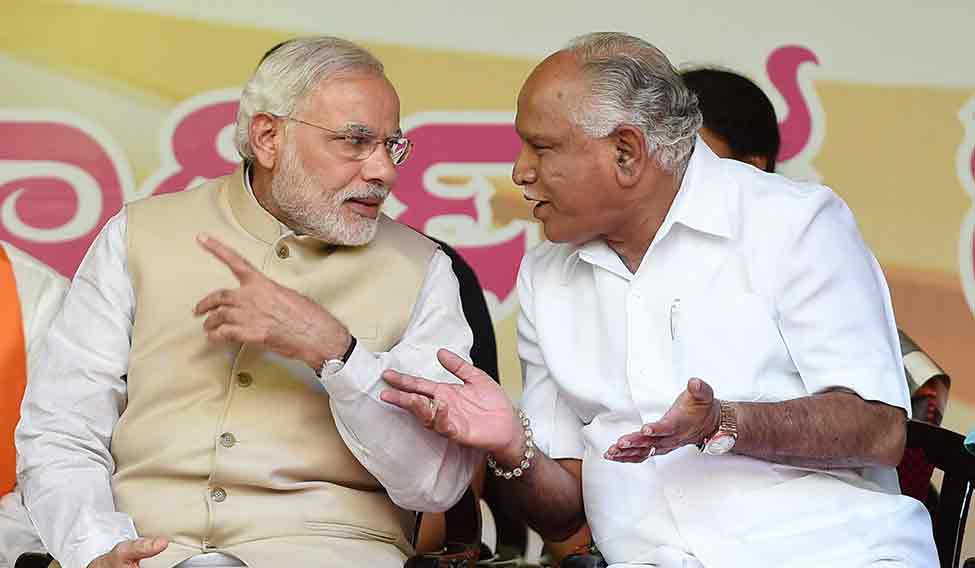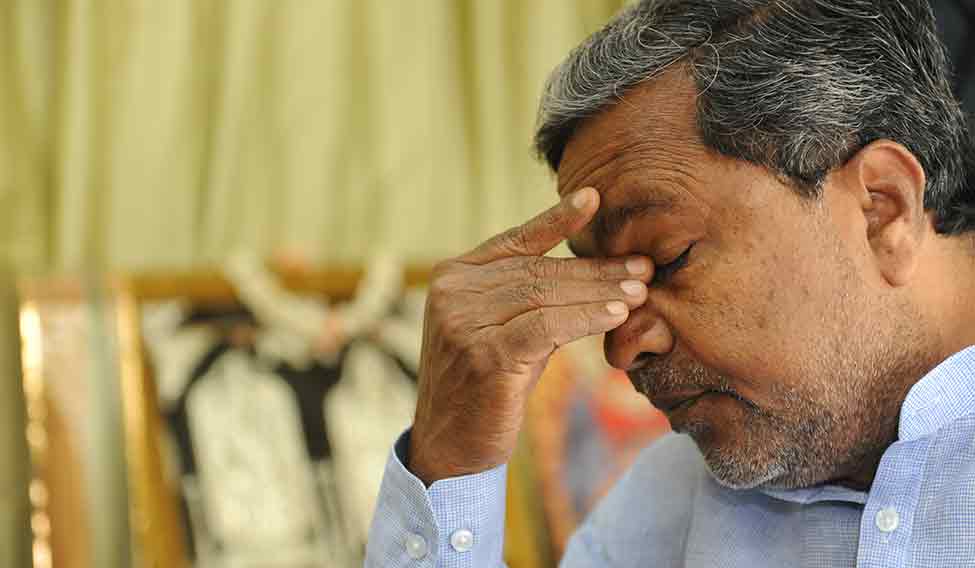We will do an Assam [in Karnataka],” proclaimed BJP Karnataka president B.S. Yeddyurappa, soon after the BJP won the assembly polls in the tea state. His appointment as state chief was part of Prime Minister Narendra Modi’s “Congress-mukt Bharat” mission. Modi's mission is fast becoming a grim reality for the Congress. Karnataka, with its 224 assembly seats and 28 Parliament seats, is the last major bastion of the Congress, which is left with smaller states— Uttarakhand, Himachal Pradesh, Manipur, Mizoram and Meghalaya—and the union territory of Puducherry in its kitty, besides sharing power in Bihar.
But it is not just the electoral fortune in Karnataka, which goes to the polls in 2018, that is at stake. The Congress has to retain power in the state to boost its diminishing prospects and bolster its image in the run-up to the 2019 Lok Sabha polls. As Congress general secretary Digvijaya Singh put it, the overall rout of the Congress since its 2014 Lok Sabha debacle is enough reason to wrap up its postmortem and begin the “major surgery”. The Karnataka BJP, which got an unceremonious exit in 2013 following a slew of corruption charges—four ministers including the chief minister Yeddyurappa landed in jail—is eyeing a comeback. If the recent baithaks in Delhi, attended by Yeddyurappa and senior leaders from the state, and the energised meetings of the youth wing and district-level leaders are anything to go by, the saffron party is already in election mode.
 Blooming tale: Modi with Yeddyurappa
Blooming tale: Modi with Yeddyurappa
The saffron surge, like the primacy of regional parties, is no longer a hypothesis. Till 1999, the BJP held less than 40 seats in the state, but it consolidated the anti-Congress vote with the gradual shift of Lingayats, a dominant community, from the Janata parivar to the BJP. In 2004, it became the largest party with 79 seats. But, the Congress and the Janata Dal (Secular) came together to keep the BJP away from power. The coalition soon crumbled and the subsequent BJP-JD(S) coalition, too, collapsed. The lotus party then swept the 2008 polls and formed the first BJP government in south India.
The Congress managed a comeback in 2013, but its victory had more to do with the common man’s ire against the scam-hit BJP than its credibility among the voters. And, now, the anti-incumbency and corruption charges, which felled Congress chief ministers Tarun Gogoi in Assam and Oommen Chandy in Kerala, are threatening Chief Minister Siddaramaiah. First, the expensive Hublot watch ‘gifted’ to him rocked the assembly, and then he was accused of nepotism when a firm owned by his son Dr Yathindra bagged government lab contracts. Even the government's move to set up an anti-corruption bureau while keeping the Lokayukta's post vacant is seen as a ploy to protect the corrupt.

Siddaramaiah’s Ahinda—Kannada acronym for minorities, backward classes and dalits—fixation has also affected the Congress’s “inclusive politics” mantra and distanced majority communities from the party, said senior leaders.
Moreover, Siddaramaiah’s ‘dictatorial’ rule has been openly ridiculed by veterans like S.M. Krishna, Mallikarjun Kharge and Janardhana Poojary. He has come under fire for relying on a coterie of former colleagues from the Janata Parivar. His critics allege that he sidelined senior leaders and delayed a cabinet reshuffle to protect ministers close to him. Then, there is the sporadic demand for a dalit chief minister.
Both Digvijaya Singh and former Union minister P. Chidambaram hinted at a “major disconnect” of party leaders with grassroots workers and called for a “reconstitution of the party at the block level”.
The Congress has little choice but to take a bold step. Going by the vote share of the three parties in the 2013 assembly polls, the Congress cannot defeat the BJP unless it joins hands with the JD(S). The combined vote share of the Congress (36.5 per cent) and the JD(S) (20.5 per cent) is enough to crush the BJP and its allies, Karnataka Janata Paksha and BSR Congress (total 33 per cent). In the 2014 Lok Sabha polls, the BJP’s vote share was only 2.2 per cent higher than the Congress's vote share of 40.8 per cent, though the BJP won more seats.
The recently concluded zilla panchayat polls also set the alarm bells ringing for the Congress. Though the party bagged 498 of 1,083 seats, with the BJP and the JD(S) winning 408 seats and 148 seats respectively, the Congress got a clear majority only in ten of 30 districts. The BJP wrested seven zilla panchayats and the JD(S) won two; 11 zilla panchayats had a hung verdict. In this backdrop, a pre-poll alliance might help consolidate Muslim votes and woo the dominant Vokkaliga community to render the secular combine a higher seat conversion.
But, before the alliance could take shape, the JD(S), too, has to quell dissent within the party and bring all its leaders on board. Also, the recent fiasco over the alleged horse-trading by the Congress to defeat the JD(S) candidate in the upcoming Rajya Sabha polls has soured relations between Siddaramaiah and Kumaraswamy, who was earlier warming up to the Congress.
The Congress will have to get its act together sooner than later.







